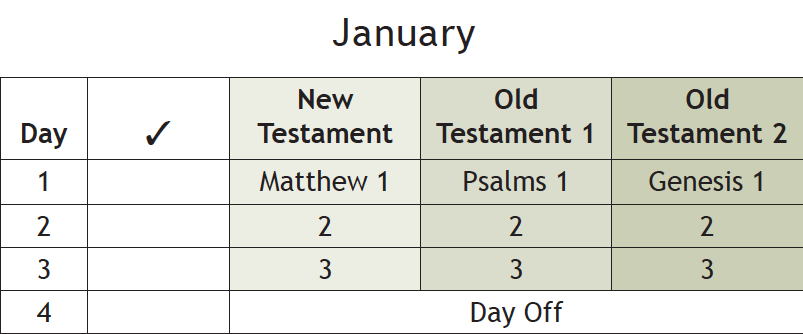Crossway makes available about 10 Bible reading plans. That link allows you to access them in a number of ways.
Here’s an overview of a few plans (some from Crossway, some from elsewhere).
ESV Study Bible (The ESV Literary Study Bible contains the same plan)
With this plan there are four readings each day, divided into four main sections:
- Psalms and Wisdom Literature
- Pentateuch and the History of Israel
- Chronicles and Prophets
- Gospels and Epistles
The introduction explains:
In order to make the readings come out evenly, four major books of the Bible are included twice in the schedule: the Psalms (the Bible’s hymnal), Isaiah (the grandest of the OT prophets), Luke (one of the four biblical Gospels), and Romans (the heart of the Bible’s theology of salvation).The list of readings from the Psalms and the Wisdom Literature begins and ends with special readings that are especially appropriate for the opening and closing of the year. The list of readings from the Pentateuch and the History of Israel proceeds canonically through the five books of Moses and then chronologically through the history of the OT, before closing the year with the sufferings of Job. The list of readings from the Chronicles and the Prophets begins with the Chronicler’s history of the people of God from Adam through the exile, followed by the Major and Minor Prophets, which are organized chronologically rather than canonically.
You can print out this PDF, which is designed to be cut into four bookmarks that can be placed at the appropriate place in your Bible reading. There are boxes to check off each reading as you complete it.
M’Cheyne One-Year Reading Plan
With this plan you read through:
- the NT twice
- the Psalms twice
- the rest of the OT once
The plan begins with the four great beginnings or “births” of Scripture: Genesis 1 (beginning of the world), Ezra 1 (rebirth of Israel after her return from Babylonian exile), Matthew 1 (birth of the Messiah), Acts 1 (birth of the body of Christ). John Stott says of this reading schedule: “Nothing has helped me more to gain an overview of the Bible, and so of God’s redemptive plan.”
If you go with this route, I’d recommend D.A. Carson’s For the Love of God (vol. 1 and vol. 2 are available–vols. 3 and 4 are forthcoming). Carson’s introduction and preface—which includes a layout of the calendar—are available for free online.
Since there are four readings each day, it’s easy to modify this one so that you read through the Bible once in two years, by reading just the first two readings each day for the first year and the second two readings each day for the second year.
Here’s a plan from NavPress, which is used each year at Bethlehem Baptist Church:
The Discipleship Journal Reading Plan
With this plan you read through the entire Bible once.
With this plan there are “catch-up” days:
- To prevent the frustration of falling behind, which most of us tend to do when following a Bible reading plan, each month of this plan gives you only 25 readings. Since you’ll have several “free days” each month, you could set aside Sunday to either not read at all or to catch up on any readings you may have missed in the past week.
- If you finish the month’s readings by the twenty-fifth, you could use the final days of the month to study passages that challenged or intrigued you.
Bethlehem makes available bookmarks that you can place in the relevant parts of your Bible:
The Journey Engage Scripture Reading Plan
The Journey, an Acts 29 church in St. Louis pastored by Darrin Patrick, is doing a church-wide reading plan this year.
This plan has you read whole chapters (a feature I like):
- one New Testament chapter
- two Old Testament chapters
They also have a couple of features designed to help those of us who have trouble persevering through a schedule like this: (1) there are lots of reflection/catch-up days; (2) they have pulled from the daily plan some of the slower-paced, harder-to-understand books. These then become “Monthly Scripture Snapshots” that are to be speed-read, along with online videos and overviews to put these books in context. See their website for more resources related to this plan.





















